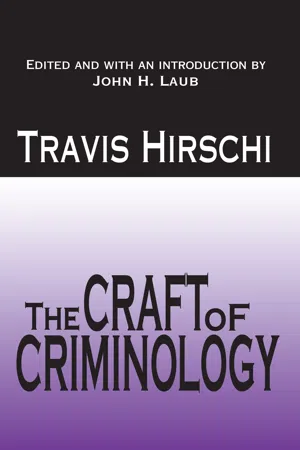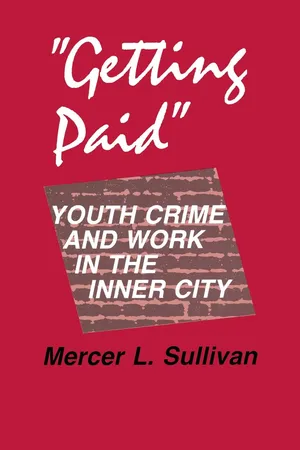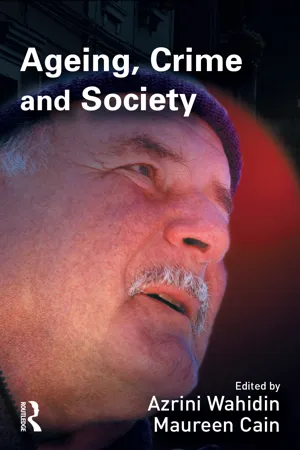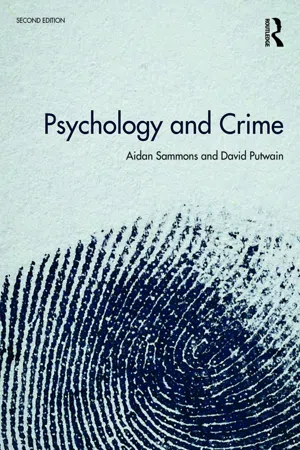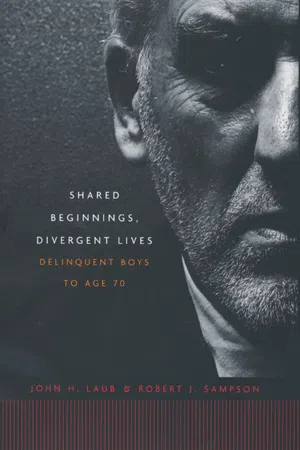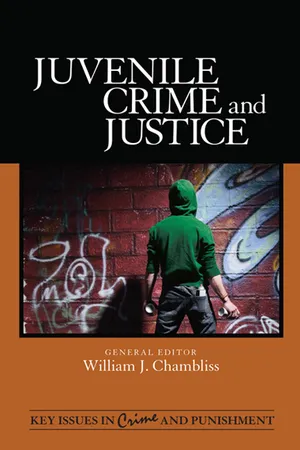Social Sciences
Age and Crime
Age and crime refers to the relationship between a person's age and their likelihood of engaging in criminal behavior. Research consistently shows that crime rates are highest among young people, peaking in late adolescence and early adulthood, and then declining as individuals age. This pattern is known as the age-crime curve and is a key concept in understanding the dynamics of criminal behavior.
Written by Perlego with AI-assistance
Related key terms
1 of 5
8 Key excerpts on "Age and Crime"
- eBook - ePub
The Craft of Criminology
Selected Papers
- Travis Hirschi(Author)
- 2017(Publication Date)
- Routledge(Publisher)
chap. 5 ; see also Wolfgang, Figlio, and Sellin 1972: 105), as have efforts to explain the relation in statistical terms (Rowe and Tittle 1977).Faced with this intransigent fact, the response in criminology has been apparently scientific and logical. Theorists are frequently reminded that their explanations of crime must square with the age distribution, and theories are often judged by their ability to deal with “maturational reform,” “spontaneous remission,” or the “aging-out” effect. Although some theories fare better than others when the age criterion is invoked, no theory that focuses on differences between offenders and nonoffenders avoids altogether the complaint that it provides an inadequate explanation of the age distribution. Given the persuasiveness of the age criticism of traditional theories, it is not surprising to find recent explanations of crime explicitly tailored to fit the accepted variability in crime by age (Matza 1964; Greenberg 1979; Trasler 1980). In fact, there is reason to believe that age could replace social class as the master variable of sociological theories of crime (see Empey 1978; Glaser 1978; Greenberg 1979).On the research side, the age effect has been instrumental in the rise of the longitudinal study to its current status as the preferred method of criminological research. The major studies of the past decade, including several now under way, have used this design (Wolfgang et al. 1972; West and Farrington 1973; Elliott, Ageton, and Huizinga 1978; McCord 1979; Wadsworth 1979). This research emphasis gains much of its attractiveness from the association between age and such concepts as “career criminal,” “recidivism,” and “desistance,” all of which are thought to be of considerable theoretical and practical import and all of which are thought to require, by definition, longitudinal designs for their study. - eBook - PDF
"Getting Paid"
Youth Crime and Work in the Inner City
- Mercer L. Sullivan(Author)
- 2018(Publication Date)
- Cornell University Press(Publisher)
To the extent that this is so, school attainment appears to be a poor proxy for intelligence. [221] Getting Paid Age. This study has certainly confirmed the influence of age on crimi-nality, yet it is not at all clear that these age effects can be understood as rooted in individual biology and psychology rather in the society. Aging clearly has both an individual and a social aspect. The fighting reported in all three neighborhoods among males in early adolescence is common in many societies and also among primates. There may well be a biolog-ical dimension to such aggression (though it has not been demonstrated directly in biomedical research on human beings; in fact, the contribu-tion of biological studies to the understanding of crime and delinquency has been minimal), yet this aggression is also channeled quite differently in different environments, as demonstrated in a vast amount of social research. Families, schools, the labor market, and the criminal justice system all construct social definitions of age-appropriate behavior, and it is these social aspects of aging which are most amenable to research and to practical intervention. In sum, this study found that individual differences did contribute to differences in criminality but that these differences were more apparent within the cliques than useful in accounting for differences at the group level. Individual age, family background, and school experience are certainly important correlates of delinquency and youth crime, but these factors cannot be neatly separated from social factors. Economic Process: Entrepreneurs and Structure Although individual-level explanations of youth crime cannot super-sede social explanations, real problems have arisen in understanding the ways in which sociocultural and economic factors influence crime and delinquency. - eBook - ePub
- Azrini Wahidin, Maureen Cain(Authors)
- 2013(Publication Date)
- Willan(Publisher)
Chapter 1Ageing, crime, and society: an invitation to a criminology
Azrini Wahidin and Maureen CainHow did it happen?
Age has been a key variable in the study of ‘conventional’ criminality and in criminological theorising at least since the Chicago School focused attention on migration, socialisation, and the young offender. Young people still predominate among those caught for conventional offending in the west, and the young were for many years the most popular subjects of ethnographic work. In spite of this, age has remained under-theorised in criminology, a last bastion, perhaps, of positivist categorisation (Cain 2003), long after ‘race’, ‘gender’, and ‘sex’ have all earned their postmodern quotation marks. Ageing as duration has been studied in relation to rates of desistance, but age as a social construction and ageing as a social process have played little part in our understanding of the phenomena of victimisation, crime, and punishment. Thus, in order to begin to theorise the relation of older people or ‘elders’ to these processes we have first had to recognise that for the ‘old’ as well as the ‘young’ very little is pre-given. We and our contributors have had to suspend our common sense upon the subject. Once this suspension is achieved, the relationship of older people to crime emerges as complex and varied, and as amenable to explanation in terms of what are by now normal post-modern theoretical categories such as subjectivity, identity construction, agency, and risk, as well as the interplay between these categories and what Powell and Wahidin (this book, pp. 17–34) have called the political economy of ageing. Before going deeper into our argument let us just point out that while domestic violence against elderly women (aged 65–74 and 75 years+) is reportedly less than it is for younger women, the rate is still higher than the rate for men in those age groups (Simmons et al. - eBook - PDF
Psychology and Crime
2nd edition
- Aidan Sammons, David Putwain(Authors)
- 2018(Publication Date)
- Routledge(Publisher)
6 The study of offenders and offending requires some agreement between practi-tioners about which people and acts should be studied. This chapter discusses dif-ferent definitions of ‘criminal’, the relationship of offending with age, gender and socio-economic status and different ways of measuring the extent of crime within society. Trends in crime and victimisation are described. Finally, there is a discussion of the psychological effects of victimisation and fear of crime in the general public. What is a crime? What is a criminal? The most straightforward answer to the question, ‘what is a crime?’ is: ‘any act that breaks the criminal law’. Under this view, criminal law sets down, in an objective way, those things that society considers harmful. This apparent simplicity hides a great deal of complexity, as it does not address the question of why some acts are criminal and others are not, or why the acts prohibited by law vary between differ-ent places and change over time. For example, purchase of alcohol by people over the age of 18 is legal in the United Kingdom but not in Saudi Arabia. An 18 year old purchasing alcohol in the UK has occasioned no crime but the very same person in many parts of the US has. And between 1920 and 1933, under the ‘prohibition’ laws, most purchase and possession of alcohol in the US was a crime, regardless of age. So the same act – the purchase of alcohol – either is or is not a crime depending on where and when it took place. Even the act of deliberately killing another human being may or may not be a crime depending on whether the killer did so in order to inherit the victim’s money, to defend herself against a deadly threat, as a soldier under orders on a battlefield or an official carrying out a judicial execution. No behaviour is inherently criminal. Rather, societies define certain acts, under certain circumstances, as criminal for a wide range of reasons. - eBook - PDF
Developmental Criminology and the Crime Decline
A Comparative Analysis of the Criminal Careers of Two New South Wales Birth Cohorts
- Jason L. Payne, Alexis R. Piquero(Authors)
- 2020(Publication Date)
- Cambridge University Press(Publisher)
Again, these effects are assumed to be small and equal between the two cohorts. Finally, the crime data used in this study are for recorded offenses only. Therefore, conclusions can only be drawn about crime that is detected and offenses for which there was an official outcome. For reasons described in the Conclusion, we believe this might help to explain some of the significant outcomes of this study. 4 Prevalence One of the least contentious issues in contemporary criminology is the functional relationship between Age and Crime – represented as the population prevalence of offending at each age. So ubiquitous is the age-crime curve that criminologists have, over several decades, described its inverted j-shape as one of criminology’ s only universal findings – a “brute fact” about crime that seems to have been replicated across multiple time periods and in almost all corners of the world (Hirschi & Gottfredson, 1983). Rising slowly at first, the age crime curve typically depicts a relatively low prevalence of criminal offending at the youngest ages of criminal responsibility. By the early teens, population prevalence of offending begins to increase steadily, each year higher than the last, until some point in early adulthood (usually the early twenties) when the relative prevalence of criminal offending begins its long (and less rapid) decline. By forty years of age, the prevalence of offending in any population cohort is often equal to or lower than it was in the 31 Developmental Criminology and the Crime Decline early teenage years and by this point only a small proportion of the population is recorded as actively engaged in crime. With respect to the 1984 and 1994 birth cohorts examined in this study, the same apparent shape appears, with population prevalence increasing (rela- tively) rapidly between the ages of thirteen and nineteen years, then falling back modestly during the twentieth year (Figure 1). - eBook - PDF
Shared Beginnings, Divergent Lives
Delinquent Boys to Age 70
- John H. Laub, Robert J. Sampson, John H. LAUB(Authors)
- 2009(Publication Date)
- Harvard University Press(Publisher)
Situational contingencies and routine activities may also lure indi-viduals toward or away from crime, and these contingencies and ac-tivities need to be systematically incorporated into our understanding of criminal trajectories over the life course. For example, we found 38 • Explaining the Life Course of Crime persistent offenders to have rather chaotic and unstructured lives across multiple dimensions (such as living arrangements, work, and family). Routine activities for these men were loaded with opportuni-ties for crime and extensive associations with like-minded offenders. Thus situational variation, especially in lifestyle activities, needs to be taken into account when explaining continuity and change in criminal behavior over the life course. Aging is another significant feature in understanding the life course of crime. There are “natural sanctions” associated with criminal of-fending—early mortality, for example. Moreover, there are health costs associated with crime and deviance. It is also apparent that both formal and informal social controls become more salient with age. That is, the influence of social bonds interacts with age and life ex-periences. As seen in work by Shover (1996) and by Graham and Bowling (1995) in Great Britain, we find in our life-history narratives that, for some offenders, there has to be an “accumulation of losses” before one becomes sensitive to the inhibiting power of informal so-cial controls. Likewise, it seems to be the case in our life-history data that fear of doing more time in prison becomes more acute with age (see also Shover 1996). Our conception of crime builds on our previous work (Sampson and Laub 1993), wherein we posited an age-graded theory of infor-mal social control. In Crime in the Making, we concluded that mar-riage, work, and military service represent “turning points” in the life course and are crucial for understanding the processes of change in criminal activity. - eBook - PDF
Criminology
Theories, Patterns and Typologies
- Larry Siegel(Author)
- 2017(Publication Date)
- Cengage Learning EMEA(Publisher)
87. R. Gregory Dunaway, Francis Cullen, Velmer Burton, and T. David Evans, “The Myth of Social Class and Crime Revisited: An Examination of Class and Adult Criminality,” Criminology 38 (2000): 589–632. 88. Travis Hirschi and Michael Gottfredson, “Age and the Explanation of Crime,” American Journal of Sociology 89 (1983): 552–584, at 581. 89. Misaki Natsuaki, Xiaojia Ge, and Ernst Wenk, “Continuity and Changes in the Developmental Trajectories of Criminal Career: Examining the Roles of Timing of First Arrest and High School Graduation,” Journal of Youth and Adolescence 37 (2008): 431–444. 90. Derek Kreager, “When It’s Good to Be ‘Bad’: Violence and Adolescent Peer Acceptance,” Criminology 45 (2007): 893–923. 91. Ronald Aday and Jennifer Krabill, “Aging Offenders in the Criminal Justice System,” Marquette Elder’s Advisor 7 (2006): 237–258. r r 92. Wanda Leal and Carrie Mier, “What’s Age Got to Do With It? Comparing Juveniles and Adults on Drugs and Crime,” Crime and Delinquency , first published online November 18, 2015. 93. James Q. Wilson and Richard Herrnstein, Crime and Human Nature (New York: Simon and Schuster, 1985), pp. 126–147. 94. Ibid., p. 219. 95. Ryan King, Michael Massoglia, and Ross MacMillan, “The Context of MarriAge and Crime: Gender, the Propensity to Marry, and Offending in Early Adulthood,” Criminology 45 (2007): 33–65. 96. Franklin Zimring and Hannah Laqueur, “Kids, Groups, and Crime: In Defense of Conventional Wisdom,” Journal of Research in Crime and Delinquency 52 (2015) 403–413. 97. Kreager, “When It’s Good to Be ‘Bad’: Violence and Adolescent Peer Acceptance.” 98. Lisa Stolzenberg and Stewart D’Alessio, “Co-offending and the Age-Crime Curve,” Journal of Research in Crime and Delinquency 45 (2008): 65–86. 99. David R. Schaefer, Nancy Rodriguez, and Scott H. Decker, “The Role of Neighborhood Context in Youth Co-offending,” Criminology 52 (2014): 117–139. - eBook - PDF
- William J. Chambliss(Author)
- 2011(Publication Date)
- SAGE Publications, Inc(Publisher)
Essential to Intervene There has also been a body of research that has pointed out the long-term consequences of avoiding intervention with children who exhibit antisocial behaviors. Developmental and life-course criminology outlines that persistent disruptive behavior at a young age is a risk factor for the development of criminal careers throughout life. Rather than excusing children for their antisocial behavior in criminal courts, some would ar-gue that it is essential to intervene in a more intensive way with those young children who present with antisocial tendencies to avert a lifetime of criminality. David Farrington, in his seminal work on the age-crime relationship, showed that the crime rate increases starting from the minimum age of criminal responsibility to reach a peak in the teenage years, and then de-clines quickly at first and then more slowly over time. Some have suggested that it is the possible specific deterrent effect on the individual offender as he or she approaches the age of majority that leads to their desistance. Other Age of Responsibility 11 researchers have shown that as offenders age, they are likely to have more responsibilities in terms of work and family obligations, and their increased responsibilities lead to their desistance from crime. Rather than focusing ef-forts on the age at which offenders should be treated as adults, some policy analysts have suggested that a more useful intervention might be to enhance the opportunities for young people to find a spouse and a job. Developing Guidelines for Age Limits New Zealand has issued a set of guidelines for government departments and public bodies when determining age limits in law and policy. The aim of these guidelines is to make certain that youth ages are used effectively and consistently in the broader policy context, without discriminating unjustifi-ably or negatively.
Index pages curate the most relevant extracts from our library of academic textbooks. They’ve been created using an in-house natural language model (NLM), each adding context and meaning to key research topics.
